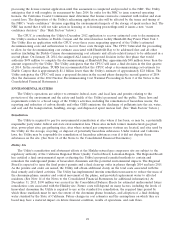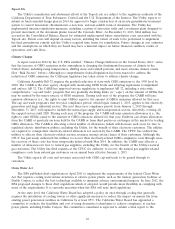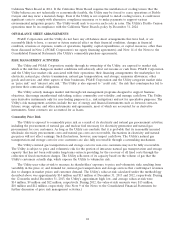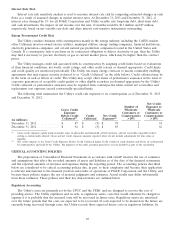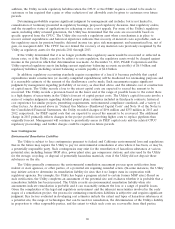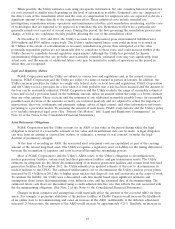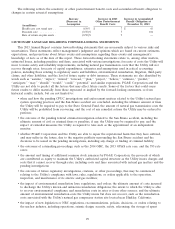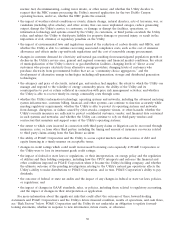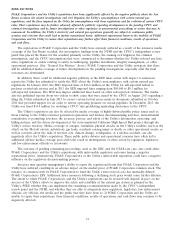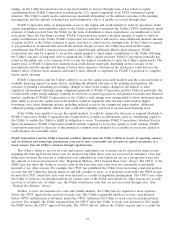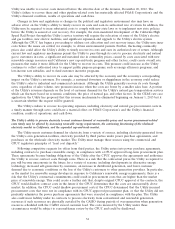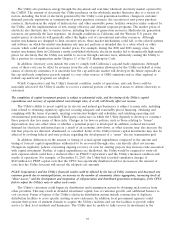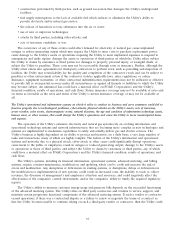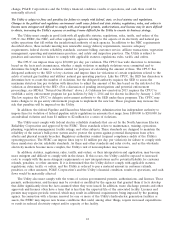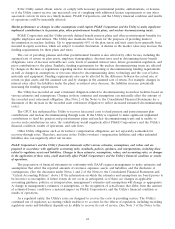PG&E 2013 Annual Report Download - page 38
Download and view the complete annual report
Please find page 38 of the 2013 PG&E annual report below. You can navigate through the pages in the report by either clicking on the pages listed below, or by using the keyword search tool below to find specific information within the annual report.PG&E Corporation’s and the Utility’s financial condition, results of operations, and cash flows could be materially affected
by the ultimate outcome of the CPUC investigations; the ultimate amount of gas transmission costs that the Utility does not
recover through rates; and the ultimate outcome of the criminal investigation, including the amount of penalties imposed and
the cost to implement any required action.
As discussed above in the section entitled ‘‘Natural Gas Matters—Pending CPUC Investigations and
Enforcement Matters,’’ the SED has recommended that the CPUC impose what the SED characterizes as a penalty
of $2.25 billion on the Utility, consisting of a $300 million fine payable to the State General Fund and $1.95 billion
of non-recoverable costs. If the SED’s penalty recommendation is adopted by the CPUC, the Utility estimates that
its total unrecovered costs and fines related to natural gas transmission operations would be about $4.5 billion and
the Utility would incur material charges in addition to the charges already incurred for the probable fines of
$200 million and unrecoverable natural gas transmission costs. Such charges would materially affect PG&E
Corporation’s and the Utility’s financial condition and results of operations and could negatively affect the
availability, amount, and timing of future debt and equity issuances by PG&E Corporation and the Utility. Future
developments in the criminal investigation arising from the San Bruno accident also could have a material effect on
PG&E Corporation’s and the Utility’s financial condition, results of operations, and cash flows. (See the sections
entitled ‘‘Criminal Investigation’’ under the heading ‘‘Natural Gas Matters.’’)
PG&E Corporation’s and the Utility’s financial condition, results of operations, and cash flows have been materially affected
by costs incurred by the Utility to perform work under the PSEP, to undertake other pipeline-related work, and to improve
the safety and reliability of its natural gas and electricity operations. The Utility forecasts that it will incur a material
amount of unrecoverable natural gas transmission costs in 2014. The Utility’s ability to recover natural gas transmission
costs in 2015 through 2017 primarily will be determined by the outcome of the Utility’s 2015 GT&S rate case.
In December 2012, the CPUC approved most of the Utility’s proposed scope and timing of projects to be
completed under the Utility’s PSEP through 2014, but the CPUC disallowed the Utility’s request for rate recovery of
a significant portion of forecasted capital costs and expenses. In October 2013, the Utility filed an update application,
as ordered by the CPUC, to reflect changes in the scope and priority of projects resulting from the Utility’s
completed search and review of records related to pipeline pressure validation and other information, including
updated cost forecasts. At December 31, 2013, the Utility had recorded cumulative charges of $549 million for PSEP
capital costs that the Utility expects will exceed the adopted cost amounts. (See ‘‘Natural Gas Matters’’ above.) The
Utility could record additional charges for disallowed costs if the CPUC does not approve the Utility’s request to
adjust revenue requirements or if cost forecasts increase. The Utility also forecasts it will incur costs during 2014 that
it will not recover through rates, including costs to identify and remove encroachments from gas transmission
pipeline rights-of-way, to pressure test pipelines placed into service after January 1, 1956, consistent with the CPUC’s
disallowance of such costs in the PSEP decision, and remedial costs associated with the Utility’s pipeline corrosion
control program.
The Utility’s ability to recover its natural gas transmission and storage costs in 2015, 2016, and 2017, will be
determined by whether the CPUC approves the Utility’s GT&S rate case application. (See ‘‘Regulatory Matters’’
above.) PG&E Corporation’s and the Utility’s financial condition and results of operations could be materially
affected if the CPUC does not approve the Utility’s request or if actual costs exceed the capital and expense
amounts that the CPUC may authorize. The Utility has not requested rate recovery for certain costs it forecasts it
will incur during 2015 through 2017, including costs to identify and remove encroachments from gas transmission
pipeline rights-of-way, to pressure test certain pipelines, and to take remedial measures to address pipeline corrosion.
Actual costs to perform this work could materially exceed forecasts and negatively affect PG&E Corporation’s and
the Utility’s results of operations. The Utility’s ability to recover natural gas transmission costs also could be affected
by the final decisions to be issued in the CPUC’s pending investigations discussed above.
PG&E Corporation’s and the Utility’s financial condition, results of operations, and cash flows will be affected by their
ability to continue accessing the capital markets and by the terms of debt and equity financings.
The Utility relies on access to capital and credit markets as significant sources of liquidity to fund capital
expenditures, pay principal and interest on its debt, provide collateral to support its natural gas and electricity
procurement hedging contracts, and fund other operations requirements that are not satisfied by operating cash
flows. See the discussion of the Utility’s future financing needs above in ‘‘Liquidity and Financial Resources.’’ The
Utility’s financing needs would increase if the Utility were required to incur unrecoverable costs and pay fines as a
result of the outcome of the pending investigations discussed in ‘‘Natural Gas Matters’’ above. Such financing may
become more difficult to obtain, especially if the ultimate outcome of the investigations affected the Utility’s credit
32


